Summer trials results from MI, IA
Now is the time that trial managers around the country are tabulating their scores and counting the “my favorite” flags and generally figuring out which of the new varieties in their trials grounds performed well.
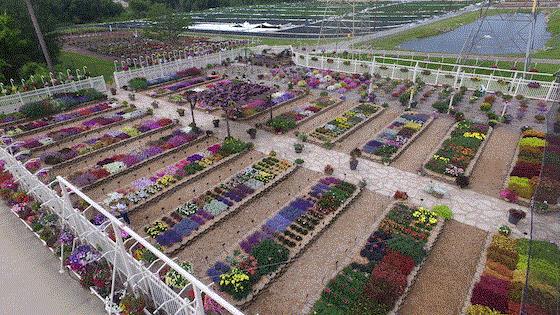
Mast Young Plants in 2021. This year's trial was just as impressive, Brian Weesies assures me.
Over in Grand Rapids, Michigan, Brian Weesies and the folks at Mast Young Plants have done a good job compiling their trial results in an online “flipbook” magazine that you can access HERE.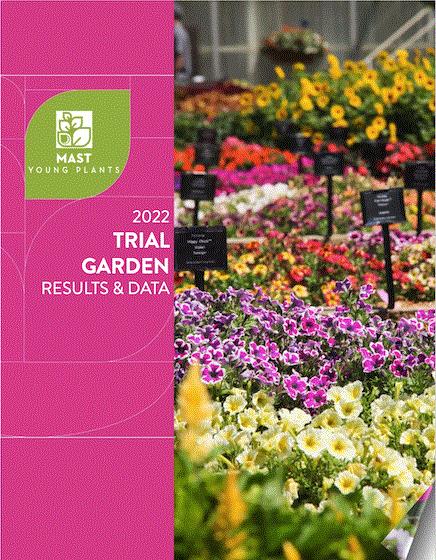
It is 37 pages of photos and captions highlighting the best of the more than 1,500 varieties they grew in their impressive display gardens. It includes “Top Consumer Favorites,” “Top Garden Performers,” “Best of the Best,” “Top Combinations,” a “Bed versus Container” petunia trial, AAS Trial standouts and more.
The photos are excellent and give you a good idea what the standouts looked like in their trials.
Plantpeddler’s video trial review
Choosing a different modern digital medium, Plantpeddler of Cresco, Iowa, produced this 10-minute VIDEO review of their annual Variety Day, which was held August 5. Like Mast, Plantpeddler grew out some 1,500 varieties—all vegetative—in large containers, hanging baskets and beds. And as per usual, expert presenters gave talks on growing culture and clean production protocols. The day included demonstrations of technology at Plantpeddler, including their ISO sticking robots.
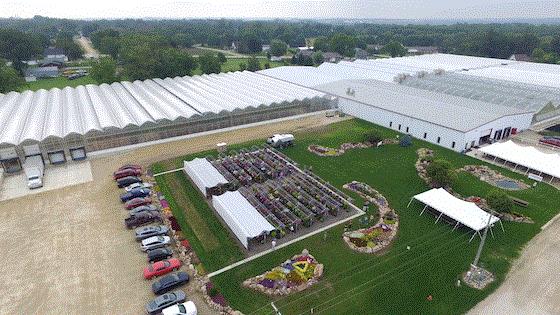
The video features reps from some of the various participating breeding companies sharing their favorite introductions. They’re biased, of course—but hey, there’s nothing wrong with letting them brag a bit about their stuff. It’s a high-quality, well-produced video and you really get a good look at the plants.
Participants had the opportunity to vote on their top three varieties. The winner this year was Begonia I’Conia Portofino Sunrise, which is in the 2023 program at Plantpeddler. But they gave accolades to the genus portulaca, which captured five spots in the Top 25—tied with Begonias for the most genus selections.
Here’s the Top 10 from the Plantpeddler trial, as voted on by visitors:
Rank Genus Series Variety Breeder
1 Begonia I’Conia Portofino Sunrise Dümmen Orange
2 Verbena Lascar Orange Lava Selecta One
3 Lantana Bandolista Red Chili Syngenta Flowers
4 Calibrachoa Rainbow Calypso Coral Dümmen Orange
5 Portulaca Mega Pazzaz Red Danziger
6 Bracteantha Granvia Gold Suntory
7 Coleus Under the Sea Barracuda USask
8 Portulaca Mega Pazzaz Pink Twist Danziger
9 Begonia Florencio Orange Syngenta Flowers
10 Petunia Itsy White Syngenta Flowers
The three favorites at Plantpeddler.
Make a note that Plantpeddler’s next trials, Poinsettia Variety Day 2022, will be Thursday, December 1. And if you’re really planning ahead, their next summertime Variety Day will be Friday, August 4, 2023.

Plantpeddler and “those dots”
Jen Zurko and I covered the Plantpeddler trials last summer, and when we did we got a brief peek at another trial they were conducting: that of Ubigro luminescent greenhouse film. It’s a brand new product, still under development, that features nanotechnology “quantum dots” that are said to actually convert unused parts of the sun’s spectrum (UV and blue) into orange, red and far-red light.
Does it do anything positive for the plant?
Plantpeddler co-owner Rachel Gooder provided the following information to Jim Gideon, sales manager for Ubigro, who passed it along to me.
Rachel reports that they had one Quonset lined with Ubigro film and a second control Quonset with regular poly covering. Each greenhouse got identical plants treated with the same water, fertilizer, insecticides and fungicides. Grow time was five weeks. Here is what Rachel had to say about five test varieties:
Alternanthera Little Ruby. “I feel this plant showed the biggest difference in growth. I think we would have been able to ship 10 days earlier.”
Angelonia. “Much taller plant but has the same amount of color.”
Bidens. “The picture does not show a big difference in the plants but up close the plants are fuller and stockier. Same height, but better plant.”
Plectranthus (below). “Fuller plant, slightly taller.”
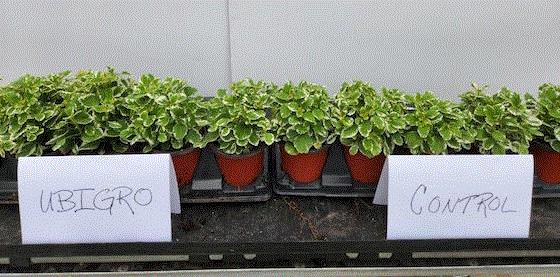
Red Celosia (below). “This plant showed a lot of difference in the growth and flowering. More color, taller plant but a stockier and fuller plant.”
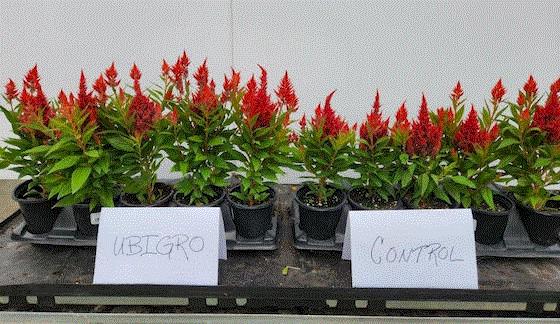
Jim Gideon told me they hope to launch a full-width Ubigro film this fall—the current product is just 49-in. wide, making it challenging to install.
Speaking of install, here’s another test installation, at an undisclosed vegetable range. You can see the narrow strips of film:

For true quantified data as to the effect of the film, let's turn to the Controlled Environment Agriculture Center (CEAC) at the University of Arizona. They've been trialing the film and provided some of their findings to our Inside Grower November 2021 issue HERE. Go to page 17 to find it.

Long Island Research Center welcomes … the president!
No, not THAT president … this was the president of Cornell University, Martha Pollack. Her visit was an honor that has only been bestowed upon Cornell’s Long Island Horticultural Research and Extension Center (LIHREC) one other time in the Center’s 100-year history.
One hundred years was the occasion for the visit: The 100th anniversary of the Center, “the nation’s only horticulture center offering expertise in every commodity, from greenhouse and floriculture to nursery and landscape plants, vegetables, and fruit,” said Dr. Mark Bridgen, professor and director of the Center.
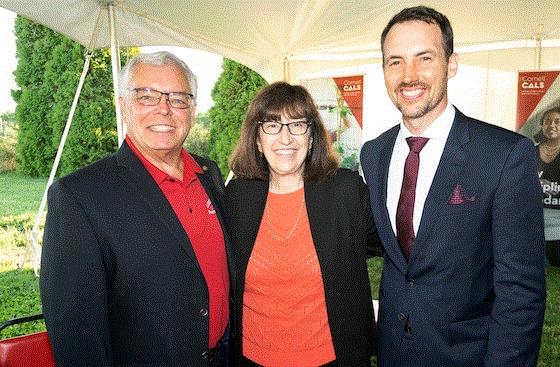
Mark (left), with the president and dean.
“We’re a one-stop shop,” he continued. “And we’re a true extension center. Most of our stakeholders are within a 50-mile radius, so we really interact with them and try to help them solve their problems with diseases or bugs.” A team of 10 scientists provides expertise across the disciplines of plant pathology, entomology, weed science and plant tissue culture.
The day included tours, and remarks from dignitaries include President Pollack, Dean Benjamin Houlton and local elected officials.
Established way back in 1922 as the Long Island Vegetable Research Farm, the current 68-acre facility includes fields and research plots, 20,000 sq. ft. of state-of-the-art greenhouse space, a plant tissue culture and micropropagation laboratory, a grape vineyard, acres dedicated to organic research and an ornamental plant nursery.
Earlier this year, the New York State Legislature approved a resolution commemorating the “pioneering research facility [that] continues to serve the diverse agricultural community on Long Island.”
Early on, the center researched commercially important crops including cabbage, cucumber, corn and potato (Ellen Wells’ family has been growing potatoes on Long Island for generations, so they certainly benefitted from that research … also, Ellen is a Cornell grad who worked at LIHREC during high school and college). Over the years, the region’s agricultural focus has shifted to fruit, vineyards and ornamental plants.
Watch this VIDEO to learn more about the Center from some of the researchers who call it home.

What the Gloeckner Foundation is funding
The smart researchers at places like LIHREC count on funding provided by worthy supporters like the Fred C. Gloeckner Foundation, whose officers and Board just awarded 10 research grants, totaling $135,843.
Here is who will be getting the grants (which range from $9,700 to $18,700) and what they are researching:
- Iowa State University, Dr. Chris Currey
Determining the effect of photoperiod, light intensity and stress on flowering and tuberization of modern begonia hybrids
- Kansas State University, Dr. Ray Cloyd
Management of western flower thrips, Frankliniella occidentalis, populations in greenhouses by combining the biological control agents the insidious flower bug, Orius insidiosus, and the rove beetle, Dalotia coriaria
- Louisiana State University Agricultural Center, Dr. Jeb Fields
Exploring soilless substrate stratification to reduce production costs
- Michigan State University, Dr. Roberto Lopez
Developing production protocols for quick cropping of containerized succulents
- North Carolina State University, Dr. Brian Whipker
- North Carolina Dept. of Agriculture, Dr. Kristin Hicks
- University of Kentucky, Dr. W. Garrett Owen
Establishing comprehensive floriculture leaf tissue standards
- The Ohio State University, Dr. Michelle Jones
Determining the influence of nutrient limitation on the root microbiome of Petunia × hybrida
- The Ohio State University, Dr. Francesca P. Hand
Sustainable disease management practices for specialty cut flowers
- University of California, Berkeley, Dr. Mary Wildermuth
Reducing powdery mildew disease and its impact on plant photosynthesis
There also were a couple of New York Florists’ Club Grants that went to the aforementioned Cornell:
- Cornell University, Dr. Neil Mattson
A chlorophyll fluorometer for greenhouse lighting research
- Cornell University, Dr. William B. Miller
Is Gerbera susceptible to chilling injury?
Thank you to all you researchers for doing good work to benefit our industry. And thank you to the Gloeckner Foundation, which, since its founding in 1960, has supported floriculture research to the tune of more than $7.4 million!

Your help needed to review research proposals
Want to support industry research but maybe don’t have the financial resources to donate to a cause? You can donate your time and experience by being a reviewer for the 2023 Specialty Crops Research Initiative (SCRI), part of the USDA’s National Institute of Food and Agriculture.
SCRI is recruiting reviewers for their 2023 cycle. SCRI provides nearly $80 million in funding each year for research and extension initiatives to address the critical needs of the specialty crop industry. This is your chance to have a say in which proposals are meeting the most urgent needs for specialty crop growers and should be considered for funding. They say the total time commitment is only 10 to 20 hours over two months, February and March. The timeline is:
- February 17, 2023: You will receive applications to review
- February 22, 2023: They hold an hour-long orientation for reviewers
- March 14, 2023: Your reviews must be completed
- March 20-24, 2023: You’ll be asked to attend a two-hour review meeting scheduled for that week.
If you’re interested in serving as a reviewer, reach out to Jessica Shade at jessica.shade@usda.gov.
Deadline is October 15.

Dramm hires two
And one of them is a returning employee: Tim Reusch returns to Dramm as a National Project Sales Manager for their DRAMMwater division, founded more than 10 years ago to help growers improve the efficiency, use and cleanliness of their water. In his new role, Tim will advise growers on best management practices for water management and irrigation while helping them to design complete systems.
Tim, formerly Dramm’s Western Technical Sales Manager for four years, returns to the company after three years working for Artemis, a cultivation management software company, and iUNU, an AI computer vision company that collects data for growers, giving them crop analysis and yield forecasting capabilities.
Joining DRAMMwater for the first time is Steven Collins, a new Field Support and Service Manager. Steven will be focused on helping customers with the installation, commissioning and support of their Complete Water Management projects. Steven joins Dramm with years of experience in field service and water system service and maintenance.

Finally …
Another factoid from the recent International Garden Center Association tour of Dutch garden centers comes data on average sale per customer. And this one the U.S. wins, at $90 (they measure in euros, but since the two currencies are about at par, euros = dollars). Here’s the chart they showed at their annual meeting:
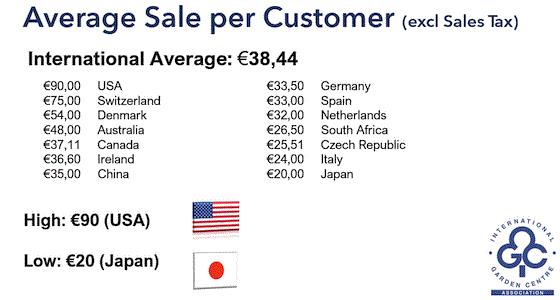
I do take this data with a bit of a grain of salt, however, because I suspect that the average U.S. customer shops less frequently than the average Dutch consumer ($32). I’d like to know how much the average customer spends per year in garden centers. I’d also like to see a sales figure for England, since they’re such a garden-crazed country, but Ireland ($36.60) might be comparable.
For more on the IGCA, click HERE. To learn about their 2023 tour to northern Italy, click HERE.
Feel free to email me at beytes@growertalks.com if you have ideas, comments or questions.
See you next time!

Chris Beytes
Editor
GrowerTalks and Green Profit
This e-mail received by 25,811 loyal readers!
Thanks to my loyal sponsors, who help me reach the 25,811 readers of Acres Online in more than 60 countries. Want to be one of them (a sponsor, that is)? Give Kim Brown a shout and she will tell you about our many advertising opportunities.